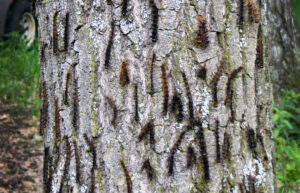
Caterpillars killed by nucleopolyhedrosis virus (NPV) hang in an inverted “V” orientation; caterpillars killed by the fungus Entomophaga maimaiga hang vertically. Photo: Wisconsin DNR.
By Bill McNee, DNR Forest Health Specialist, Oshkosh
bill.mcnee@wisconsin.gov or 920-360-0942
With this spring’s dry weather in Wisconsin came predictions of the largest spongy moth population in years.
When spongy moth populations are high, we often see heavy mortality of the larger caterpillars due to two pathogens. Heavy caterpillar mortality will reduce the severity of the following year’s outbreak and often causes a population crash during the current year. If a heavy die-off of caterpillars is observed, please let your local DNR Forest Health Specialist know about it.
The two pathogens to watch for:
- Nucleopolyhedrosis virus (NPV): This causes dead caterpillars to hang in an inverted “V” orientation that is sometimes referred to as “wilt disease.” It’s a naturally occurring virus present in the insect’s population. A high proportion of larvae can become infected when caterpillars are abundant because there are many opportunities to transmit the virus to other caterpillars.
- Entomophaga maimaiga: This is an introduced fungus that can quickly infect and kill spongy moth caterpillars. Caterpillars that die from this fungus hang vertically, head down. This fungus is most effective at reducing caterpillar populations when spring weather is wet.
Mortality should be most noticeable between mid-June and mid-July, depending on location, and can appear quickly. The two differing types of dead caterpillars are commonly seen on the same tree, and both are often filled with a brown, foul-smelling liquid. The next heavy rainfall usually washes the cadavers to the ground.
Last summer, we saw limited caterpillar mortality from these agents in most locations. So far in the spring of 2023, we have had well below-average precipitation levels in the southern third of the state. As a result, the resulting effectiveness of E. maimaiga is likely to be limited.
Later this year, be on the lookout for newly produced egg masses that are smaller than normal. These are often produced by a female moth carrying a sublethal dose of the NPV virus. A noticeable proportion of small egg masses is usually a sign that the spongy moth outbreak is trending downward and is past its peak intensity.
To predict the severity of an outbreak in 2024, conduct egg mass surveys this fall when all eggs have been produced. This information will help landowners determine the need for an aerial spray in 2024.
You can find additional information about spongy moth management and diseases here.
